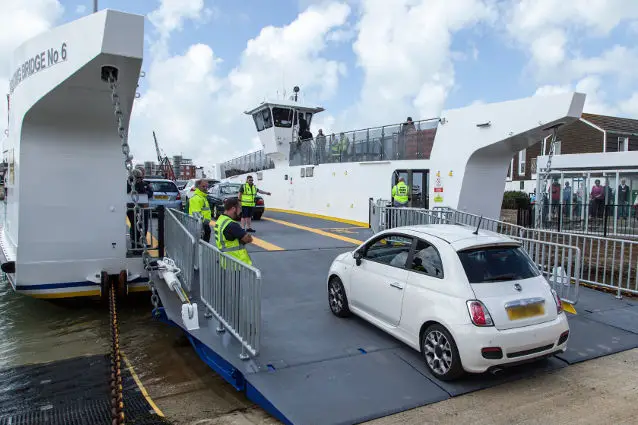Angie Booth shares this latest on behalf of the Floating Bridge Stakeholders’ Group. Ed
This morning, we can see that the Council has not made all of the necessary improvements to the Cowes floating bridge to meet the Statement of Requirements, specifically those that ensure that this floating bridge is at least even as good as the last.
If this floating bridge is infrequent and unreliable, let alone unsafe or putting boats in peril, it won’t work.
Grounded three times
“Testing” during neap tides and with little river traffic is inappropriate and renders falsely favourable results i.e. confirmation bias – getting the results you want by fixing the circumstances to make things work the best.
Last week during spring tides the floating bridge grounded three times badly. The floating bridge will be less likely to ground these next weeks during neaps, but there are many other issues, despite a few small ones that have been resolved.
Unresolved design problems
There are many unresolved design problems that, all together, make the floating bridge slower, less reliable and more expensive to run as well.
This ranges in a very long list (not all listed here) – not only the noise and the chains – including: requiring all pedestrians to leave through one exit; grounding its boxy front easily on the slipway, necessitating costly regular dredging; driving slightly visually impaired with only one central wheelhouse that also needs extra staff to assist onboard for a variety of reasons, including that it takes too long for the driver to come down two flights of stairs to open the gates.
Passenger accommodation lacking
This floating bridge is supposed to have ‘improved passenger accommodation’ yet instead it has 50% less sheltered space for pedestrians and horrible lack of access for people with disabilities, all of whom can’t stand in the cold and rain for a half hour waiting for a slow floating bridge; people won’t use it, and this has real impact on the towns, Newport traffic, and the Council’s coffers as well.
Shops need customers.
Businesses will die
We were promised a floating bridge better than the last one, and this one still fails on all accounts. The Council can’t afford the risk of accepting this bridge, because if it is at times much slower and grounds more frequently than the old bridge, people won’t use it, and the Council will lose money, the traffic in Newport will be debilitating, and businesses will die.
This is no joke, and it has gone on long enough.
Council must reject this floating bridge
Unless radical and expensive fixes are done, such as building another sheltered pedestrian area, cutting out several metres in the length of the bridge, and building a wheelhouse on each end (amongst other things), this will not be a long-term success.
Sadly, these types of engineering feats are so expensive that they probably would also require EU tendering, would cost even more money, and wouldn’t even be guaranteed to work. It would cost almost the same as starting from scratch. The Council must reject this floating bridge and stop the sticking-plaster attempts; the time that is being wasted is costing the Council and the people dearly.
Former floating bridge was profitable
Many people do not know that the previous floating bridge made a hefty profit for the IW Council with the vehicle fares, because the Council didn’t ring-fence those profits for the floating bridge and instead spent them on other things.
It has been wrongly assumed that the Council pays for the floating bridge operation when in fact it has been a money-maker. If this floating bridge is slower and less reliable, it will cost the Council money (it will not make a profit) and not do its job. A bad floating bridge won’t make a profit.
If you were sold a banger of a new work van that you must have in order to work, and the warranty/trial period was about to run out, would you accept that van, knowing it probably would cost you money and break down on you? And what if you knew that you had to keep it for 20-30 years? You wouldn’t.
Sell FB 6 and buy a new one
The Council should do the best thing: take out a low-interest loan, sell off this floating bridge whilst it is still new and hasn’t depreciated in value, and use the money from the sale of the floating bridge and some of the future profits from fares to pay back the loan which wouldn’t take long at all.
Normally taking out a loan is a bad idea, especially if you can’t reasonably guarantee that you can repay it. But a well functioning floating bridge makes a very good profit, and a new floating bridge – and the sale of this one – can pay for its own loan.
The Council could also buy a stable, disabled-access Jenny boat for a fraction of the amount that they pay out to hire one, and run an excellent launch service in the meantime. That all makes good business sense, and we’re sure that the Council can see that is in their best financial interest as well as the interest of Cowes, Newport, and East Cowes.
It can’t be fixed
We all wish this floating bridge could be fixed, but it can’t. We don’t blame the Council necessarily for what is wrong with the bridge, but now that it’s clear that action to fix it properly has not been taken, the responsibility for rejecting this floating bridge sits squarely on the Council’s shoulders now.
We as Islanders also are concerned that the Council and its individual officers may be leaving themselves open to liability.
We’d also like to thank the floating bridge staff who are operating under such difficult conditions and trying to make things work in spite of problems.
Please do the right thing and the best thing for the people and the Council – buy a new floating bridge that is closer to the size and shape of Floating Bridge 5.
Article edit
Reference in intro text corrected from ‘interest-free loan’ to ‘low interest loan’.
Image: © With kind permission of Allan Marsh





